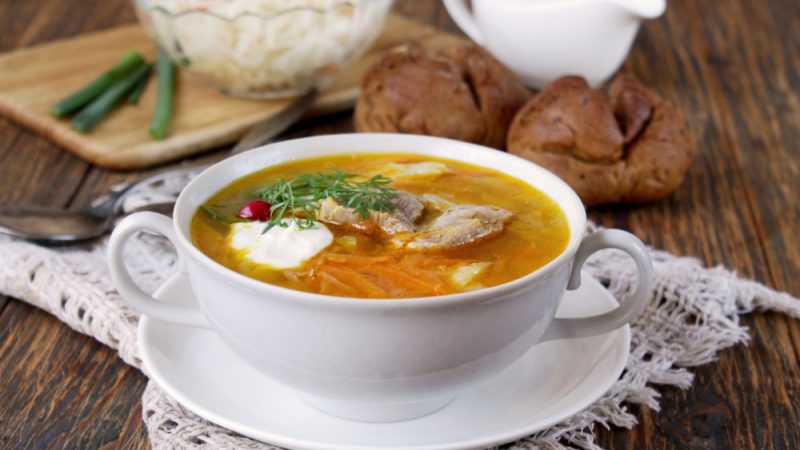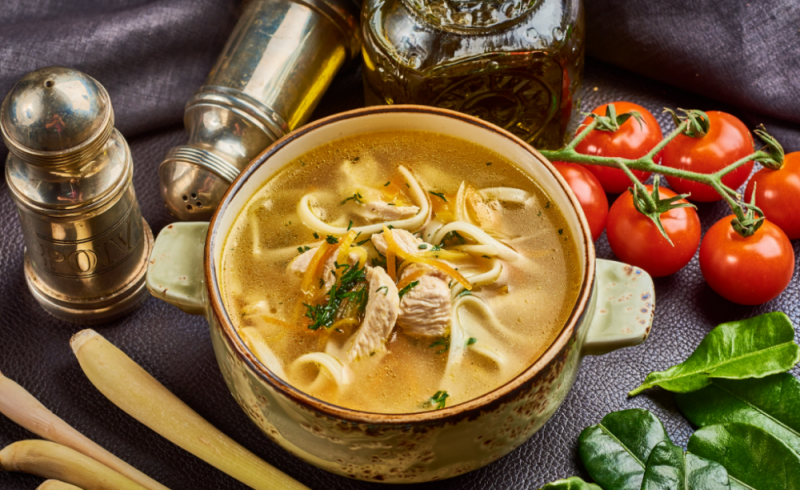Those who monitor the correctness of their nutrition do not start eating the contents of the plate until they have calculated its nutritional value. Proponents of this lifestyle will probably want to know how many calories are in the soup - a dish that a person needs to consume daily to maintain a healthy body. If you consider yourself among the adherents of the PP, let us understand this issue together.
Material Content:
Chemical composition and nutritional value
The chemical composition of the soup directly depends on the ingredients that it contains. Moreover, the differences between the varieties of this dish can be very significant. The presence of meat plays an important role, because it gives a large amount of protein to the broth. So, a pound of beef will increase the protein content in the fat to 100 g, fat - up to 50 g.
Other components affect nutritional value to a lesser extent.
Imagine the value of vegetables at the rate of each 100 grams:
- cabbage - 1.8 g of protein, 0.1 g of fat, 4.7 g of carbohydrates;
- potatoes - 2 g of protein, 0.4 g of fat, 18.1 g of carbohydrates;
- carrots - 1.3 g of protein, 0.1 g of fat, 6.9 g of carbohydrates;
- celery root - 1.3 g of protein, 0.3 g of fat, 6.5 g of carbohydrates;
- onions - 1.1 g of protein, 0.1 g of fat, 9 g of carbohydrates.
The chemical composition of any broth can also be analyzed in detail. All variations of pottage have the same set of macronutrients, vitamins and minerals. The difference is only in their quantity.
Consider the contents of 100 g of soup using chicken broth as an example:
- potassium - 2500 mg;
- beta-carotene - 5 g;
- sodium - 1300 mg;
- phosphorus - 800 mg;
- magnesium - 400 mg;
- Vitamin A - 900 mcg;
- vitamin B - 1.5 mg;
- Vitamin C - 90 mg.
These indicators may change with the addition of a product.
How many calories are in the soup
The energy value of the broth depends on the volume of ingredients, their fat content and nutritional value.
The most light and low-calorie vegetable soup is considered. One serving of such a dish contains an average of 43-61 kcal, where the minimum value corresponds to a stew mainly from vegetables. The calorie content of pea soup will be much higher. In addition, if it is not cooked on water, but on meat broth, the energy value automatically grows by 40-80 kcal.
Meatballs also significantly increase the calorie content of the final dish. Since pork meat is used mainly for their manufacture, which in itself is already quite oily, the broth also turns saturated. Different parts of pork carry an unequal amount of energy.
So, indicators per 100 g:
- scapula - 250 kcal;
- drumstick - 257 kcal;
- brisket - 550 kcal;
- ham - 300 kcal;
- neck - 340 kcal;
- shank - 330 kcal.
As for vegetables, they are much easier and faster absorbed by the stomach.
Their calorie content in boiled form, as a rule, does not exceed 100 kcal / 100 g:
- potatoes - 80 kcal;
- onion - 13 kcal;
- carrots - 15-19 kcal;
- peas - 41 kcal;
- cauliflower - 9 kcal;
- beans - 48 kcal.
Special attention should be paid to the issue of adding pasta and dairy products to the soup. Macaroni add about 52 kcal per serving to the broth, sour cream - 20-45 kcal.
Ways to reduce calories in the first dishes
If your favorite food is high-calorie, then you should not immediately refuse it. There are ways to reduce the energy value of a dish, which will allow you to use it even during weight loss. All qualified professionals who make up diets insist that a diet should create a calorie deficit rather than a nutrient deficiency. They suggest replacing fatty foods with their less nutritious counterparts. For example, the calorie content of borsch can be reduced by replacing pork with chicken. This will help to win about 500 kcal per pot (volume 3 l).
In parallel with this, you can trim the whole skin and fat from the bird. This will take another 100-130 kcal. Meat products can be completely replaced and cooked with mushroom (13 kcal) or bean broth (48 kcal). Whatever the composition, after cooking it must be filtered. This will not only slightly reduce the energy value of the broth, but also make it more attractive in appearance. And finally, the "grandmother" way of degreasing the soup. After it has stood for a couple of hours in the refrigerator, a thin layer of fat appears on the surface. If you collect it, the dish will almost twice lose its calorie content.
The benefits of soup for the body
Broths and soups are a must in the diet of every person. In addition to the fact that they contain a large amount of nutrients, the liquid in their composition helps to establish the proper functioning of the gastrointestinal tract. It is not in vain that people who have undergone serious surgery are recommended to use a light diet broth. Chicken soup contains vital peptides, amino acids, and unsaturated fats. They help to start the proper functioning of the stomach.
Depending on the ingredients, soups to one extent or another contain many useful substances, vitamins, sodium, calcium, potassium.
The use of broths is an accompanying therapy for colds, pressure disorders.
This dish contains about 50% liquid, therefore, it helps to normalize its level in the body and stabilize the patient's condition.
Various first courses, no doubt, are important components in the diet of any person. By choosing the right balance of ingredients, you can create a unique recipe for your favorite treat, which is right for you.
















